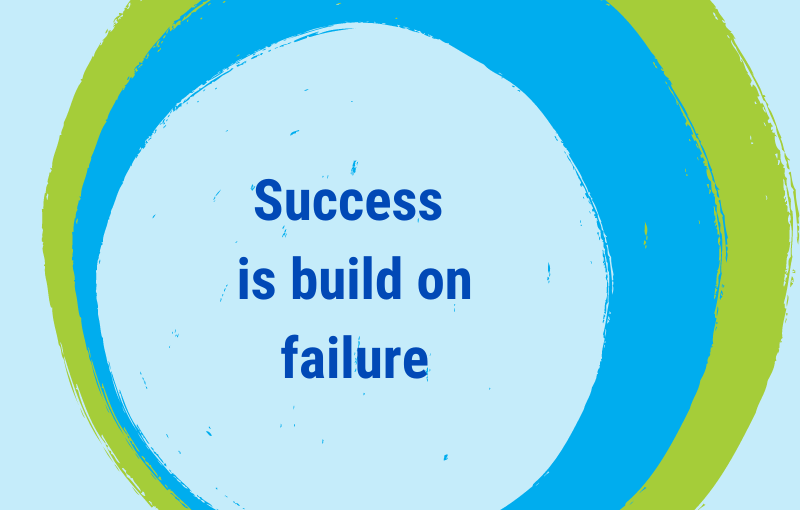Our failures can help us become more successful
If we set ourselves goals, there is always the risk that we don’t reach them, that we fail.
And what we often do, because of that ‘risk’ of failure – we pull back:
We let go of that goal completely or we make it smaller, easier to achieve.
There is nothing wrong with this as long as we feel happy and content about the achievement of those smaller easier goals.
If, however, we feel dissatisfied, disappointed, frustrated, if we cannot truly enjoy the results we currently have, we might want to have a closer look at our fear of failure that holds us back from working on big(ger) goals.
Some time ago, we talked about ‘How to fail successfully’.
We discussed that the only reason why we try our very best to avoid failure is because we try to avoid the bad feelings we expect to show up if we miss our expectations and desired results.
And that the only reason why we connect bad feelings with failure is because we have negative thoughts about failing.
We are the ones who decide what failure means to us.
Unfortunately, we very often decide to think about failed expectations in a negative way, in a way that creates negative feelings like disappointment, shame, pain.
The recommendation in the article mentioned above was to deliberately start getting good at failing by doing it often and by appreciating failures as learning opportunities.
Today we want to discuss the second suggestion a bit deeper:
How to deliberately use the learning and growth potential of failures.
Imagine you would always win.
You would achieve all the goals you set yourself and create any results you wanted to have. No matter what you did it was a success.
No challenges and obstacles to overcome, no difficulties to move out of the way, no two steps forward and one backward, always all expectation met.
Wouldn’t that be boring?
Not only boring but probably even awful. Because winning effortlessly all the time would also mean:
no opportunities for self-development and growth, no need for experimenting, no innovation and new – and potentially better – ways to approach things and move forward.
Failure has much to offer
Most of us don’t want to spend time with our failures. Instead, we want to move on and forget about ‘what went wrong’.
But we can learn so much from our failures – if we take the time and effort to understand what they want to tell us.
We can decide on purpose to use any failure as a neutral (not negative!) source of information, offering valuable insights and ideas for innovation.
Three powerful questions to create success from failure
(Source: Stacey Boehman, 2k program)
-
- What worked?
- What didn’t work?
- What am I going to do differently?
Let’s have a look how this works.
EXERCISE
Decide to invest some time to really evaluate a failure experience. Sit down and take out a piece of paper and a pen.
Step 1 – Choose a recent failure that you want to evaluate
Think about your recent failures. And pick one. It could be something small or big.
‘Failure’ examples:
-
- You didn’t get the job you applied for.
- A prospect didn’t become a client.
- You lost a tennis match.
- The sweater you knitted doesn’t fit.
- You didn’t achieve your weight loss goals.
- The weekend trip with your mother-in-law was a disaster.
Step 2 – Start working on the first question: What worked?
You mind might want to immediately offer answers to the question what didn’t work – ignore it for now.
It is important to start with thinking about what worked because that brings you to a more positive place and makes you open to the insights that can be gained.
List everything that went well. Every little thing. Don’t let yourself off the hook, keep writing.
Ask, for example,
-
- What did I do well?
- Which of the actions I took were effective?
- What helpful thoughts did I have?
- What useful beliefs did I create?
- What ideas?
- Etc.
List anything that brought you in the intended direction.
Step 3 – Now answer the second question: What didn’t work?
Try to be open and curious, and non-judgemental.
Keep the list as neutral as possible, avoid negative adjectives. This is just about creating an inventory of the things (actions and thoughts) that didn’t work out, it’s not about collecting accusations.
Ask, for example,
-
- Which thoughts or beliefs got into my way and kept me from doing what had to be done?
- In which ways didn’t I show up like I wanted?
- Did I lack certain skills or necessary knowledge?
- Etc.
Step 4 – Finally think about this: What are you going to do differently?
Based on your answers to the other two questions you can now make a plan and list what you want to do differently in future.
This step is vital for our development and our future successes, but most of us don’t do it – because we are so eager to get away from the failure experience.
What you are going to do differently is your new roadmap.
Even if your next goal is different from this missed one, you will still benefit from what you learned here if you make a plan how to apply it in your next project.
“We think we fail and go backward. We only go back when we give up. When you fail, you’re moving forward.” (Brooke Castillo)

